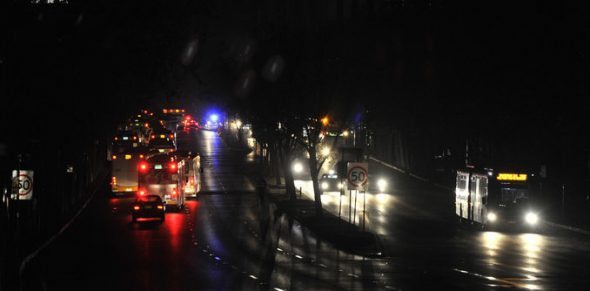
Power is gradually returning to South Australia after wild storms blew across the state last night, but some areas could be offline for days.
The storm – associated with heavy rain, lightning, and severe winds – damaged transmission lines that carry electricity from power generators to people, causing a state-wide blackout.
South Australian premier Jay Weatherill told ABC radio, “the system operated as it was meant to operate”.
However senator Nick Xenophon, in calling for an independent inquiry, said “there are key questions that need to be asked”. He has also questioned whether more gas-power stations would have prevented the power failure. Deputy prime minister Barnaby Joyce pointed the finger squarely at the state’s reliance on renewable energy.
So, what did cause South Australia’s blackout?
Was it because of wind or wind turbines?
Dylan McConnell, Research fellow, Melbourne Energy Institute, University of Melbourne
It has everything to do with wind – because that’s what blew over the transmission lines. But it has nothing to do with South Australia’s wind turbines. Transmission lines are large power lines that take electricity from generators to the smaller distribution lines that bring power to our homes.
South Australia’s energy generation mix is mixture of wind, gas and some solar, and as of this year, zero coal. The state is connected to the rest of eastern Australia’s electricity market through two inter-connectors, one of which is down for service.
Where the transmission lines, managed by ElectraNet, came down is south of Port Augusta. In May this year South Australia closed its last coal-power station at the port. If those coal-power stations were still operating, they still would have dropped offline and seen the cascading failure that tripped the generations. Having those thermal generators there wouldn’t have helped at all.
A lot of generation capacity was lost because of the transmission failure. Because of that there was a voltage drop, which triggered safety protection measures that tripped the Haywood inter-connector that connects South Australia with Victoria. This could have happened in any state or with any generation technology.
Roger Dargaville, Deputy Director, Energy Research Institute, University of Melbourne
These kinds of failures in the National Energy Market (NEM) which covers the five eastern states) are extremely rare. The NEM experiences a range of extreme weather on a regular occurrence and a vast majority of the time copes well.
The system contains multiple levels of redundancy and safety mechanisms, however it is impractical if not impossible to build any complex system that is completely 100% reliable. Providing additional redundancy to insure against such events would be extremely costly, and would still not completely guarantee against further extreme events.
That being said, as we find out more about the incident it may become apparent that there are weaknesses in the grid that need addressing. However it is hard to imagine how the high penetration of renewable energy in the state could be implicated in this incident.
Just under 1,000 megawatts of wind power was dispatching onto the grid at the time of the blackout with another 400 megawatts from gas plant and 300 megawatts supply from the Victorian inter-connector making up the total. Had either of the brown coal generators still been in operation the system would not have been any more resilient to this event.

Was it climate change?
Andrew King, Climate extremes research fellow, University of Melbourne
The role of climate change in the storm that hit South Australia yesterday is unclear. With these types of storm systems it is much harder to see the human fingerprint than it is for heatwaves for example.
For intense rainfall events like yesterday’s you need two main ingredients: a lot of moisture in the atmosphere and a trigger, such as a deep low pressure system. We know that climate change is increasing the amount of moisture in the air, but the human influence on the frequency of the triggers is far less clear.
In general the storms that track across southern Australia are moving southwards with climate change. For very intense storms like the one that hit South Australia yesterday we don’t have enough data to make a definitive statement on how they’re changing in this region.
We can’t say that climate change was to blame for this storm without a full analysis of the event.
More to come.
Authors: Andrew King, Dylan McConnell, and Roger Dargaville.
![]() Source: The Conversation. Reproduced with permission.
Source: The Conversation. Reproduced with permission.










